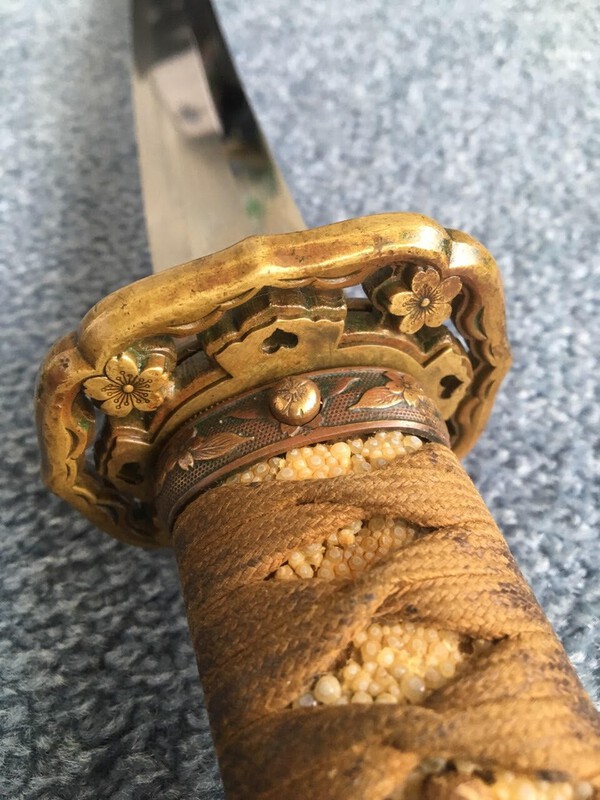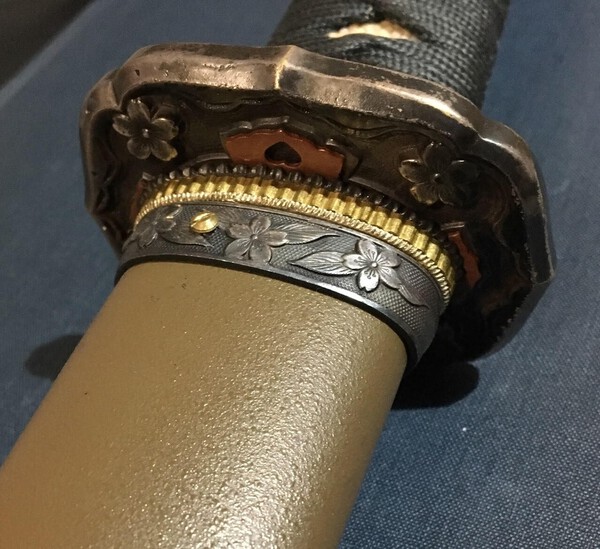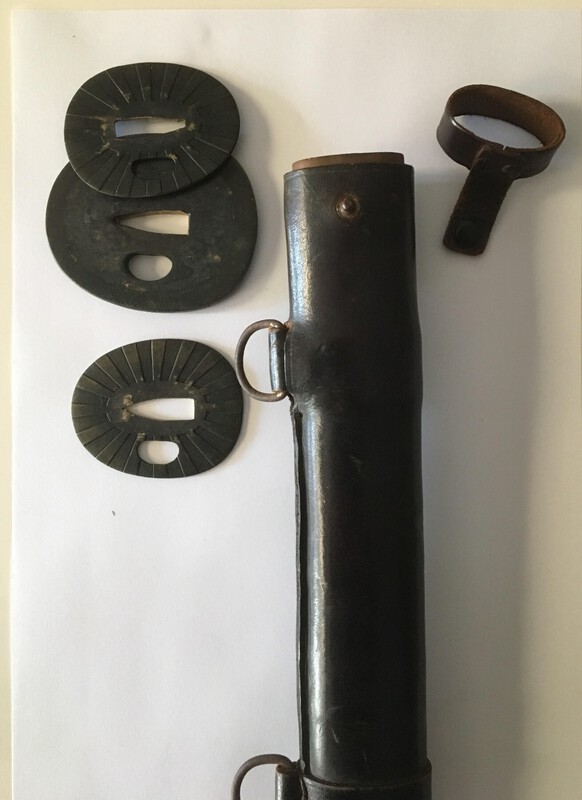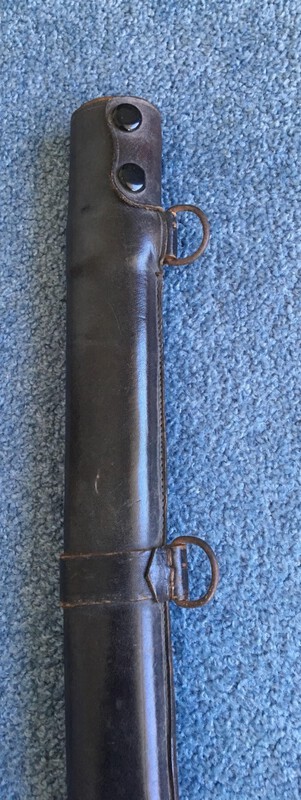-
Posts
1,902 -
Joined
-
Last visited
-
Days Won
85
Everything posted by IJASWORDS
-
Volker, here is a KOTANI YASUNORI of mine. Aluminium saya, pierced tsuba etc. The interesting thing about my YASUKUNI SHRINE swords, is that the fittings are marked with the SUYA COMPANY of TOKYO logo. To your knowledge, was SUYA the authorized fittings supplier to Yasukuni swords?
-
Bruce, nice idea. The Nihonto Message Board, Military section is turning into a pretty good reference site for WW2 swords. The work you guys have done on Mantetsu and Stamps for example, have added additional knowledge on the subjects. With your permission I will kick off the discussion with what I know, and what I have in my collection. Starting off with a 1944 MASANAO. But first a bit of background. In 1940, discussions were conducted between Senior Naval personal and Chief Priest Goto of the MINATOGAWA JINJA (shrine) with the objective of establishing the KIKUSUI TANTO KAI, (The Kikusui Sword Forging Association). The swords forged here would be presented to select Naval Officers. So in late 1940 a temporary forge was set up, then in late 1941 the forge was moved to the grounds of the Minatogawa Shrine in Kobe. These swords would be distributed by the Japanese Naval Academy. The art names of the swordsmiths were given the prefix MASA, this was bestowed on them in honor of MASAshige, a defeated commanding officer of Emperor Go-Daigo, who in 1336 committed seppuku. A shrine honoring Masashige was built in 1872, this is the Minatogawa Shrine. The Shrine was bombed and destroyed on March 17 1945. The sword smiths who produced swords at the shrine were .... MASATADA MASATAKA MASAAKI MASANAO MASAYOSHI MASAKIYO. The swords made here are true Nihonto. In general the swords are signed, MINATOGAWA JINJA MASA.... The Navy requested that the swords be made in the Ko-Bizen style, with suguha or ko-choji hamon. It is estimated that only about 3900 swords were ever made at Minatogawa, and many of these are at the bottom of the sea! Hence their rarity and collectability. So this is a MASANAO sword. Masanao's name was Okada Yoshiaki (1917-1972), the features of this sword are Nagasa 66.5 cm, sori 2.3 cm, in Itame hada and Gunome Choji Hamon. The KIKUSUI Mon (chrysanthemum on water) is on the nakago and habaki. This is the symbol of the Japanese Navy of the time. I welcome any additional information, corrections and other examples.
- 24 replies
-
- 11
-

-
I put this up for no other reason than personal indulgence. When I feel a little weary of swords, I pull this out and re-charge my "collecting batteries". You can get lost in the hada and hamon on this February 1944 Amatsu MASAKIYO. And his "squiggly wiggly" (I think that is a technical term), signature and mei cutting. A page from that great book by SLOUGH goes into a little detail about this RJT, High-Grade smith. To be honest, I am amazed Masakiyo doesn't have a high Yen rating.
-
Dunno Bruce, but a similar one of mine has a similar dedication to the TAGA SHRINE in Japan, and the God of protection, DAIMYOJIN lives there.
-
Geoff, yes black dyed shark skin same.
-
As I indicated in a post on this subject, I believe the sarute cord color closely matches the handle wrap ITO. For me a missing piece of the puzzle, was how was a Navy cord sarute tied? Remembering that an important part of sea faring was rope skills, and tying knots, you would imagine that a simple granny knot would not go down well with a Navy officer. I have come across some tied like the attached photos. I have no idea how to reproduce the knot, and I will not un-tie this one to find out! But it certainly looks Nautical to me.
-
-
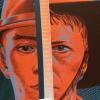
Bamboo Leaf pattern Tsuba on Gunto with old blade
IJASWORDS replied to Baka Gaijin's topic in Military Swords of Japan
-
A cord sarute color normally matches the color of the handle wrap Ito, both on Navy and Army. A mismatched color normally means the sarute has been added later.
-
Don't know if I have put this up before, but it's nice enough to see again, An ICHIMONJI MINAMOTO AMAHIDE KORE KITAERU , no date no stamps, that some officer thought enough about to spend a few extra YEN putting in nice mounts. A tan painted saya, with blue Ito handle wrap, and blackened fittings. It is possible the sarute is gold plated.
-

Toshinaga (Jumyo) 1941 - just to share for info
IJASWORDS replied to Erwin's topic in Military Swords of Japan
KATO JUMYO made some nice traditionally made Gendai swords. One of mine with the mei, KATO JUMYO, and probably a special order, with a poem by Rai San'Yo . Rough translation ... "Even when you are in the deepest swamp, you are obliged to your country". In '98 mounts. Nice hada and hamon. -
-
Rob, I have a 1933, and that price is very close to the going rate today!
-
-
Thought I would kick off a thread on Horimono on Gunto swords in WW2 mounts. These are all by Kanetoki/Kanemichi (the same sword smith). So I would love to see others, whether Gendai or old blades remounted for war.
-
Tang photos are upside down. Can you invert them please, makes them easier to read, thanks.
-
Could someone help with this part of a MEI, which is the name of the person for which the sword was made, thanks.
-

Attention Mantetsu Owners: A Survey
IJASWORDS replied to Bruce Pennington's topic in Military Swords of Japan
So Bruce, following all the work you, Thomas, Trystan and Ohmura have done on Mantetsu, can we now assume the following .... !. Blades were manufactured by the Manchurian Railway Company, from their own puddled steel. 2. Some blades were finished at the Nanman factory in China. 3. The mune stamps were, for a better word, tracking numbers or production numbers, stamped in one or other factory in China. And the mei look all cut to a set style . 4. Finished blades were shipped to Japan for mounting, distribution and sale. This appears confirmed from orders and delivery information and documents. 5. There is NO evidence of any Mantetsu/Koa Isshin blades being made in Japan. 6. We know that during the war, blades were in short supply, and the Mantetsu/Koa Isshin solution was an "outsourcing" exercise. So the "light bulb" over the head moment for me was the realization that ALL the blades are made in China, and none in Japan! It would not surprise me either if puddled steel from the Manchurian Electric Furnace was sent to Japanese sword smiths as a substitute for the limited supply of traditional tamahagane. I have examples of Mantetsu swords with Chinese Manchurian Railway Company stamps, as well as Nanman and Dairen stamps from 1938-1944. So without being too controversial, there are actually blades that are papered MADE IN CHINA. All this being said, the Mantetsu blades were highly praised and sought after by the Japanese Officers. I would be interested in comments on the above. -
I understand this is the Kiri Mon, with the Paulowinia flower motif. This is on a '94 mounted Gunto. I have seen it used for the Japanese Government. My question is, what relevance does it have for a family or clan? Or is it a Government sword.
-
-
-
I still enjoy finding the small variations found on Shin Gunto. Often written about, not often seen, the "thin" sarute, on the left.
- 1 reply
-
- 1
-

-
Nice KYU Gunto!
-
I should have added that the sword is secured by a snap tab, and uses the fairly rare pierced tsuba/seppa set.
-







